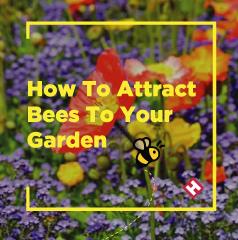Westland provide some fantastic tips & advice on attracting pollinators especially Bees to your garden.
Visit their website for more advice on this - Westland Website
How Bees Help us in the Garden
Bees play a vital role in the garden and they’re an essential part in the pollination of a plant during its life cycle. Bees visit flowers to collect nectar and pollen, which they then use as food for themselves and to help feed the larvae in their hives or nests. Insect pollination can also be carried out by many other pollinating insects including butterflies and moths and are essential for the cropping of most fruits and some vegetables.
Therefore, as bees are so vital, it’s important that we all encourage bees into our gardens throughout the year. Planting nectar and pollen rich flowers will help to do this.
What Plants Attract Pollinators?
When you’re choosing plants for attracting bees and other pollinators, it’s best to avoid plants with double or multi-petalled flowers e.g. Hydrangeas, Double-begonias, Petunias, Busy Lizzies. These plants don’t offer much nectar or pollen bees, also the bees may find them difficult to access as their flowers are filled with petals.
Flat or shallow blossom plants such as daisies, zinnias and asters, will attract the largest variety of bees. Long-tongued bees will be attracted to plants in the mint family, such as nepeta, salvia, oregano, mint and lavender. Long-tongued bumblebees are attracted to flowers with hidden nectar spurs, such as larkspur, monkshood and snapdragons.
Bees are more drawn to blue, purple and yellow flowers and therefore, find them the most appealing. Bees can see the colour purple more vividly than the majority of other colours.
As Bees are most active between March and September, it’s great to choose a selection of plants that will flower across the different months of most of the season so you can attract bees all year round. One flower in particular that is great to have in the garden and flowers pretty much every day of the year is Erysimum bicolor ‘Bowles’s Mauve’
Create a Home for the Bees in your Garden
Insect House

To help attract bees into your garden and to make sure they have a reason to stay, why not create a home for your bees? An easy way is to install an Insect house or a Bee box in your garden, this will provide a home and will give more nesting opportunities for solitary bees and insects, therefore, encouraging them to nest in your garden. Our Natures’ Haven Woodland Insect Box is perfect for this.
Deadwood Habitats
Another option is to create a deadwood habitat within your garden. This simple, easy to create idea helps to create a more natural environment. Simply, find a few logs of wood and pile them up horizontally. Bees prefer sunnier locations, but if you deadwood habitat the same in a shadier location you’ll be sure to see lots of other insects and beetles too.
Bee Stumps
Find a sunny section of your garden, as this is where bees prefer to nest, and place some taller logs or wooden posts of approximately 2 metres in length into the ground in an upright position. To make the nesting areas for the bees, simply drill lots of holes of different depths and sizes into the posts. Smaller bees such as the yellow-faced bee will use smaller holes usually around 2-3mm across, and larger bees such as wool-carders, leafcutters and masons will use the larger diameter holes of 8-10mm.
Provide Water
Just like us humans, bees and other pollinators need water to survive. A pond is a natural and safe source of water that allows bees to easily drink from.


